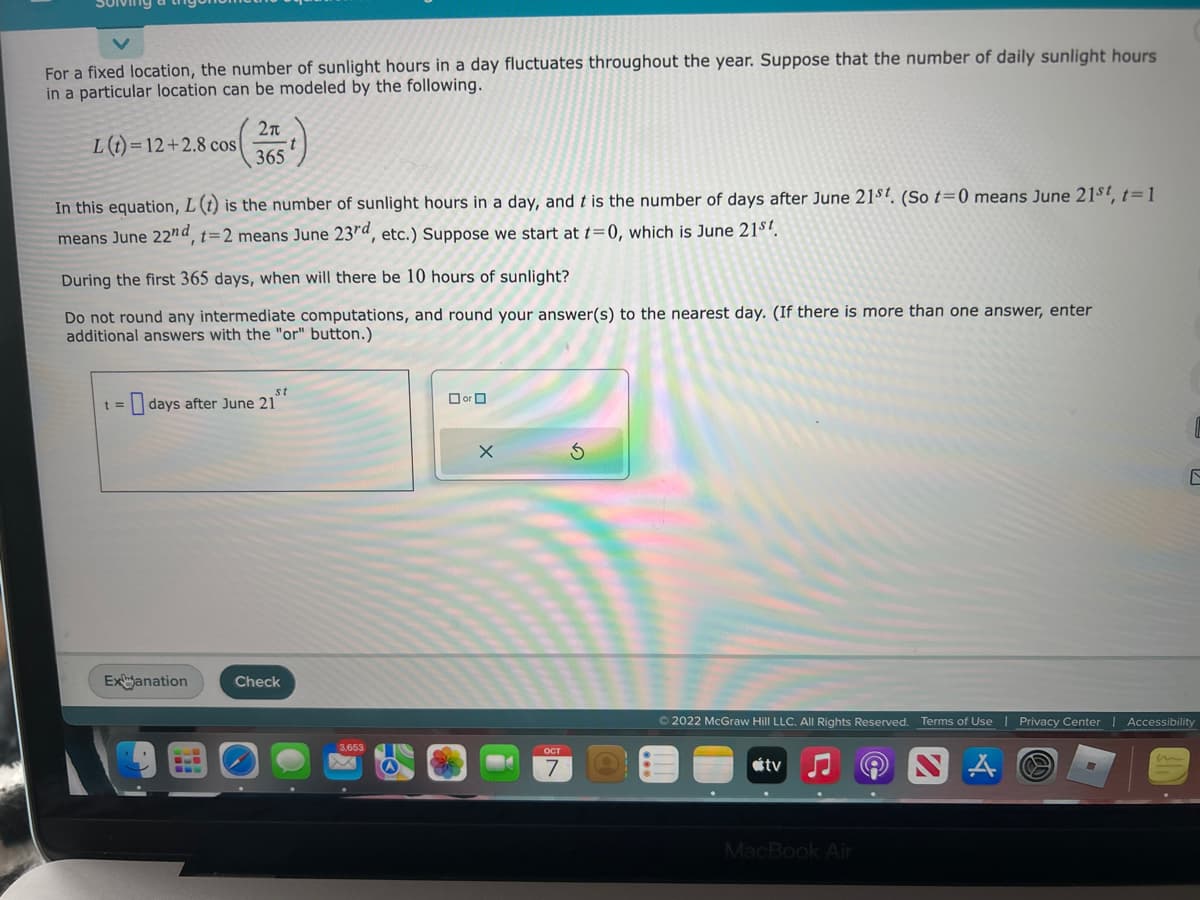For a fixed location, the number of sunlight hours in a day fluctuates throughout the year. Suppose that the number of daily sunlight hours in a particular location can be modeled by the following. L(t)=12+2.8 cos 2π 365 In this equation, L (t) is the number of sunlight hours in a day, and t is the number of days after June 21st. (So t=0 means June 21st, t=1 means June 22nd, t=2 means June 23rd, etc.) Suppose we start at t=0, which is June 21st. During the first 365 days, when will there be 10 hours of sunlight? Do not round any intermediate computations, and round your answer(s) to the nearest day. (If there is more than one answer, enter additional answers with the "or" button.)
For a fixed location, the number of sunlight hours in a day fluctuates throughout the year. Suppose that the number of daily sunlight hours in a particular location can be modeled by the following. L(t)=12+2.8 cos 2π 365 In this equation, L (t) is the number of sunlight hours in a day, and t is the number of days after June 21st. (So t=0 means June 21st, t=1 means June 22nd, t=2 means June 23rd, etc.) Suppose we start at t=0, which is June 21st. During the first 365 days, when will there be 10 hours of sunlight? Do not round any intermediate computations, and round your answer(s) to the nearest day. (If there is more than one answer, enter additional answers with the "or" button.)
Glencoe Algebra 1, Student Edition, 9780079039897, 0079039898, 2018
18th Edition
ISBN:9780079039897
Author:Carter
Publisher:Carter
Chapter7: Exponents And Exponential Functions
Section7.8: Transforming Exponential Expressions
Problem 13PFA
Related questions
Question

Transcribed Image Text:For a fixed location, the number of sunlight hours in a day fluctuates throughout the year. Suppose that the number of daily sunlight hours
in a particular location can be modeled by the following.
L(t)=12+2.8 cos
In this equation, L (t) is the number of sunlight hours in a day, and it is the number of days after June 21st. (So t=0 means June 21st, t=1
means June 22nd, t=2 means June 23rd, etc.) Suppose we start at t=0, which is June 21st.
2π
365
During the first 365 days, when will there be 10 hours of sunlight?
Do not round any intermediate computations, and round your answer(s) to the nearest day. (If there is more than one answer, enter
additional answers with the "or" button.)
t =
st
days after June 21
Exanation
Check
3.653
☐or
X
S
Ⓒ2022 McGraw Hill LLC. All Rights Reserved. Terms of Use | Privacy Center Accessibility
tv
C
MacBook Air
Expert Solution
This question has been solved!
Explore an expertly crafted, step-by-step solution for a thorough understanding of key concepts.
This is a popular solution!
Trending now
This is a popular solution!
Step by step
Solved in 2 steps with 1 images

Recommended textbooks for you

Glencoe Algebra 1, Student Edition, 9780079039897…
Algebra
ISBN:
9780079039897
Author:
Carter
Publisher:
McGraw Hill


Functions and Change: A Modeling Approach to Coll…
Algebra
ISBN:
9781337111348
Author:
Bruce Crauder, Benny Evans, Alan Noell
Publisher:
Cengage Learning

Glencoe Algebra 1, Student Edition, 9780079039897…
Algebra
ISBN:
9780079039897
Author:
Carter
Publisher:
McGraw Hill


Functions and Change: A Modeling Approach to Coll…
Algebra
ISBN:
9781337111348
Author:
Bruce Crauder, Benny Evans, Alan Noell
Publisher:
Cengage Learning

Trigonometry (MindTap Course List)
Trigonometry
ISBN:
9781337278461
Author:
Ron Larson
Publisher:
Cengage Learning


Algebra & Trigonometry with Analytic Geometry
Algebra
ISBN:
9781133382119
Author:
Swokowski
Publisher:
Cengage